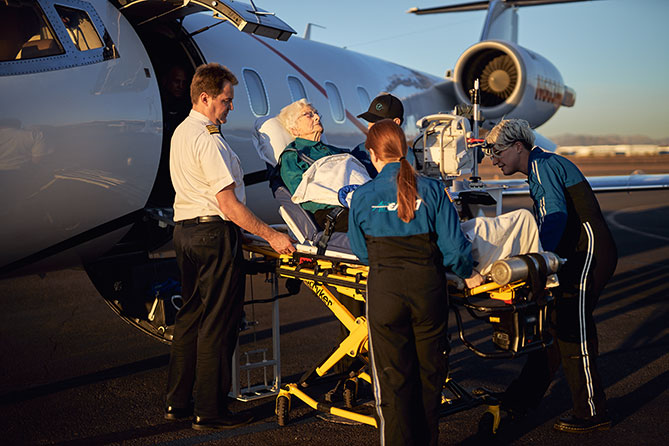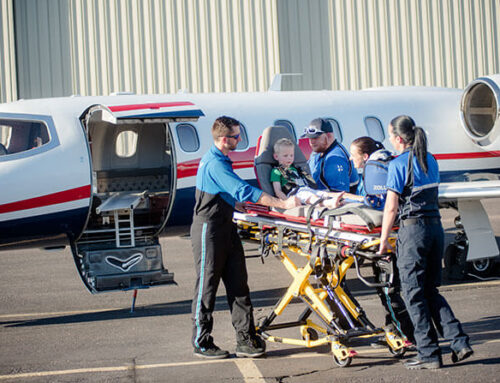You have a patient that needs to be transported from your facility to another facility at another location. We understand this can be a daunting task if not done very frequently. What is your first step? Where do you start? How can you best support your patient and family members?
The first thing to do is take a deep breath and relax. We are here to guide you through this process and prepare you with the right tools to make it as easy and stress free as possible. Below is a guide for the steps you can take and what you need to know along the process.
1. Medical Transportation Options
You’ll need to first determine what kind of medical transportation services your patient needs. Most patients in critical condition will need an air ambulance flight, which offers multiple options. There are also other options such as medical escort services, where patients just need a helping hand to get to their destination on a commercial airliner. Our communication specialists can help guide you and your patient through this decision.
When to Choose a Long-Range Air Ambulance Transport
Your patient is in critical condition, in a stretcher, and requires the use of hospital grade equipment to stay stable during their transport. These transfers are typically above 350 miles from one state to another state or to/from an international location. Services include bedside to bedside medical care, dual piloted fixed-wing Learjet Air Ambulance transport, and a 2 staff medical crew utilizing hospital ICU grade medical equipment onboard. Read more about our air medical transport services here.
When to Choose a Short-Range Rotor Medevac Transport
Your patient is emergent, trauma, or in critical condition and needs to be transferred directly to another medical facility close by, typically inner-city or state. This transport includes a single pilot helicopter, 2 staff medical crew with life-saving EMS equipment. To better understand the difference between rotor and fixed wing air ambulance services read our guide showcasing which aircraft to use for an air ambulance medical transport.
When to Choose a Commercial Medical Escort
These patients are in very stable condition, but might have mobility issues due to fractured bones, psychiatric issues, or other difficulties preventing them from travelling alone on a commercial airliner. They are able sit up for take-off and landing and can transfer out of a wheelchair but needs medical support. A medical professional travel alongside the patient bedside to bedside, including ground transportation to and from the airport and medical equipment to be used on the commercial flight when needed. Typically, their doctor will provide approval for such travel. Read more about our Commercial Medical Air Escort services here.
2. Obtain a Quote
The next step is to call an Air Ambulance company for a quote. Preparation is important in this kind of situation. The best solution is to establish and develop a relationship with reputable air ambulance and commercial escort providers for your patients before you need these services. This entails calling them and ask questions. This way when you have a patient that needs to be transported you will be ready with great options for them to choose from without delay.
Although the internet certainly makes it easy to search for an air ambulance or medical escort company, it is often very difficult to ascertain if the company you are calling is the real deal or a broker. A broker does not own the aircraft, but rather finds a company for you. Brokers charge a fee for their services that is embedded in the quote. The fee is anywhere from a few hundred dollars to thousands of dollars. Some brokers find the cheapest provider possible so they can make the highest profit for themselves. It’s best to go to the air ambulance or commercial medical escort provider directly.
3. Choose a Provider that provides an all-inclusive quote
There are some great companies out there, and yes, there are some companies that are not so great. Be your patient’s advocate! This is why you do what you do – to help your patients. Part of helping is to make sure they don’t get themselves in a predicament. Remember, your patient and family members are under a lot of stress and might not have all the information or mindset to make an informed decision.
Contracts should be short and sweet. Be aware of lengthy contracts. If your patient receives a long- contracts, review the contract with them to ensure there are no hidden snares. Beware of quotes that mention retainer fees or estimates, and those that require signatures before providing a final quote. These quotes might mean the quoted rate is only the minimum cost of the flight- however there could be a strong possibility of a price increase after the flight. Back billing happens often in this industry by those providers that are not honest, don’t let your patient fall into the trap of having to pay unknown additional fees long after they have been transported.
4. Pick the Provider with the highest standards of care and safety
The best way to ensure a provider has the highest standards is to choose only an accredited Air Ambulance provider. Learn more about the importance of accreditations here. Accreditations such as CAMTS, EURAMI or NAAMTA are several accrediting bodies for our industry. Accrediting companies provide standards and an auditing process to ensure air ambulance providers adhere to the standards set forth by the accrediting bodies. CAMTS was the first to recognize the need for stringent, monitored safety and training standards and has been considered the gold standard of the industry. EURAMI is an accrediting organization with its roots in Europe but audits providers worldwide. NAAMTA is the most recent accrediting body developed to broaden standards to allow more providers accreditation. By choosing an accredited provider, you will have a much higher chance of choosing a company with good standards.
Don’t be afraid of asking questions of a provider! Transparency is key! It would be good to ask the following questions to help decide the best and safest company for your patient. What is the providers safety record? Are their employees hired by the company or are they contracted? For air ambulance providers- do they own their own aircraft as well as their own operating certificate? These factors are what builds a safe and comfortable environment for your patient during a medical transport.
Every day we know why AirCARE1 was started – to make a difference in our patients’ lives by providing care with empathy and compassion that advances the healing process. We set certain standards and requirements to earn patient trust and achieve peace of mind. We have found that some providers focus more on personal gain while taking advantage of these difficult medical emergency situations to reach their goals. The outcome for any medical transport should be based on what is right for the patient while transporting them in the safest manner.
5. Decide on the best service(s) to present to your patient
As you gain more knowledge and understanding, you will be able to help your patients make the best decision possible regarding air medical transport. Your help and support can make this process easier for them in their time of need. You have the experience and the knowledge to help them know what’s best for them in this situation and they will be forever grateful for your help. You can make a positive impact in their lives as they navigate through this difficult time. Help them avoid the pitfalls that can deter them away from anything but a positive outcome at the end of this.
AirCARE1 would of course love to do all of your transports, but we realize we might not always be the best fit for your patient. We are transparent, truthful, and honest – if we are not able to transport your patient, we can certainly find another reputable company who has the correct licensures and accreditations. Our referral list includes direct air ambulance and commercial medical escort providers, not brokers.
Please feel free to call us at 877.760.7760 or reach out via email if you have any other questions or need guidance.




